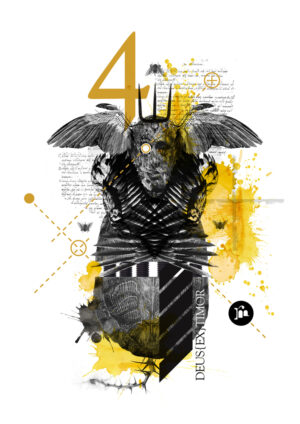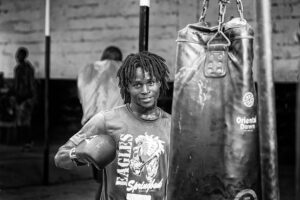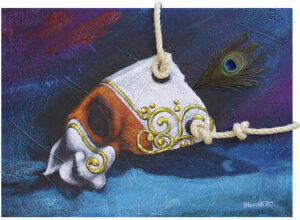Modernism in Brazil: a turning point in the art history
Gaining wide recognition with the Semana da Arte Moderna, the movement provoked several controversies around its ideas.

Modernism in Brazil was a post-World War I aesthetic movement that tried to bring national life and thought into line with modern times, creating new Brazilian-origin methods of expression in the arts.
In the struggle against academicism and the European influence that dominated art in Brazil, the modernists rejected the traditional dependence on Portuguese literary values, trying to reflect Brazilian colloquial discourse (instead of “correct”) in their works and often dealt with Brazilian themes. distinct, based on native folklore and legends.
The Brazilian modernist movement
Modernists experimented with literary form and language, using free verse and unconventional syntax, but their concern with literary reform was primarily a means of social reform.
Modernism in Brazil gained wide recognition with the Semana de Arte Moderna, an event held in São Paulo in 1922, which caused controversy with lectures on the goals of modernism and readings of works by modernist poets such as Mário de Andrade.
O modernismo no Brasil ganhou amplo reconhecimento com a Semana de Arte Moderna, evento realizado em São Paulo em 1922, que causou polêmica com palestras sobre os objetivos do modernismo e leituras de obras de poetas modernistas como Mário de Andrade.
Obras em Destaque
The movement, however, soon split into several groups with different goals. Some modernists, among them Oswald de Andrade, focused specifically on the nationalist goals of the movement that were stirred up by radical social reforms, while Manuel Bandeira, generally considered the greatest among modernist poets, sympathized with his aesthetic principles but lost interest in his activism. political.
The Week of Modern Art
Held in São Paulo in 1922, the Modern Art Week was considered a turning point in the history of Brazilian culture.
Organized by a group of intellectuals and artists on the occasion of the Centenary of Independence, the main objective of the week was to declare a break with cultural traditionalism associated with previous literary and artistic currents, such as Parnassianism, symbolism and academic art.
The defense of a new aesthetic point of view and the commitment to the cultural independence of the country made modernism synonymous with “new style”, directly associated with the production carried out under the influence of 1922.
Main artists of modernism in Brazil
Heitor Villa-Lobos in music, Mário de Andrade and Oswald de Andrade in literature, Victor Brecheret in sculpture, Anita Malfatti and Di Cavalcanti in painting, these are some of the participants of the Modern Art Week.
Scholars consider the period from 1922 to 1930 to be the period in which the artists’ first commitment to aesthetic renewal is evident, benefiting from their close contact with European avant-gardes (cubism, futurism, surrealism, etc.).
This effort to redefine the artistic language was linked to a strong interest in national issues, which stood out from the 1930s onwards, when the ideals of 1922 were disseminated and normalized.
Although modernism in Brazil was thought of from its multiple expressions (in Rio de Janeiro, Minas Gerais, Pernambuco, etc.), the Semana de Arte Moderna was an eminently urban and São Paulo phenomenon, connected to the growth of São Paulo in the 1920s, industrialization, massive migration of foreigners and urbanization.
Works that represented the movement
The impetus would have come from painting, from Di Cavalcanti’s role in organizing the event, from Brecheret’s sculptures and, above all, from Anita Malfatti’s exhibition in 1917.
Anita’s works from this period (O Homem Amarelo, a Estudante Russa, A Mulher de Cabelos Verdes, A India, A Boba, O Japonês…) showed a commitment to the teachings of modern art: the free brushstroke, the problematization of the relationship figure/ground, the treatment of light without conventional chiaroscuro.
Di Cavalcanti’s works, on the other hand, went in another direction. Self-taught, the artist worked as an illustrator and caricaturist. The simple and stylized line would become the hallmark of his graphic language, while the painting, begun in 1917, did not have a defined orientation.
Di Cavalcante’s works revealed a certain eclecticism, alternating a romantic and “penumbrist” tone (Boêmios, 1921) with inspirations from Pablo Picasso, Georges Braque and Paul Cézanne, which led him to the geometrization of form and the exploration of color ( Samba and Modelo no Atelier, both from 1925).
Brecheret was the sculptor of the modernist group, and was often compared to French sculptors Auguste Rodin and Emile Antoine Bourdelle by critics of the time.
The chromatic contrasts and ornamental elements of Henri Matisse’s painting, in turn, were present at the root of works such as Woman and Landscape (1931). Meanwhile, Italian education and French experience marked the sculptures of Brecheret, author of the model for the Monument to the Flags (1920), and of 12 pieces exhibited at the Semana (among them, Cabeça de Cristo, Daisy and Torso).
The much-acclaimed artist Tarsila do Amaral was not present at the 1922 event, which did not take her place as a great exponent of Brazilian modernism.
Associating the French experience and learning with André Lhote, Albert Gleizes and Fernand Léger to national themes, the painter produced an emblematic work of the modernist group’s concerns. From French painting, especially from Léger’s “animated landscapes”, Tarsila took the image of factory machines as an icon of industrial and modern society.
The gears produced precise aesthetic effects, providing a language to the works: their contours, colors and modulated planes introduced movement to the canvases, as in E.F.C.B. (1924) and The Gare (1925).
This first “pau-brasil” phase, characterized by native landscapes and lyrical figurations, was followed by a short anthropophagic period, 1927-1929, which erupted with Abaporu (1928).
The reduction of colors and elements, the dreamlike images and the surrealist atmosphere as in Urutu, O Touro and O Sono, from 1928, mark the essential features of that moment. The trip to the USSR, in 1931, was at the origin of a social shift in the work of Tarsila (Operários, 1933), which coincides with the nationalist inflection of the period, exemplarily represented by Candido Portinari.
Portinari was and still is the typical expression of 1930s modernism. The research of national themes, the strong social and political accent of the works were associated with Picasso’s Cubism, Mexican Muralism and the School of Paris (Mestiço (1934), Woman with Child (1938) and O Lavrador de Café, 1939).
Lasar Segall, trained in the German expressionist lexicon, approached the modernists in 1923, when he settled in Brazil.
Part of his work, wide and diversified, recorded the landscape and local figures in line with modernist concerns, as he represented with excellence in Mulato 1 (1924), and in O Bebedouro e Bananal (1927).

Although the term modernism refers directly to the production carried out under the aegis of 1922 – which also includes the names of Vicente do Rego Monteiro, Antonio Gomide, John Graz and Zina Aita – modernism in Brazil must be thought of in a broader sense, including works prior to the 1920s (those by Eliseu Visconti and Castagneto, for example), and research that went beyond the Modern Art Week, such as those of artists linked to the Santa Helena Group (Francisco Rebolo, Alfredo Volpi, Clóvis Graciano, etc. ).
The Phases of Modernism in Brazil
First generation (1922-1930)
The first generation defined the truly specific meaning of modernism in Brazil, because although innumerable new processes and ideas were launched, the modernist movement was essentially destructive.
The First Phase of Modernism was characterized by the attempt to define and mark positions, being rich in ephemeral circulation manifestos and magazines. It was the most radical period of the modernist movement, precisely as a result of the need to break with all the structures of the past. Hence the anarchic character of this first modernist phase and its strong destructive meaning, as defined by Mário de Andrade.
The search for the modern, original and controversial, with nationalism in its multiple facets, were outstanding characteristics of this initial phase. The return of origins, through the valorization of the indigenous and the language spoken by the people, were also addressed.
However, nationalism was used in two different ways: the critical, aligned with the political left through the denunciation of reality, and the boastful, exaggerated and extreme right.
Due to the need for definitions and a break with all the structures of the past, it was the most radical phase, assuming an anarchic and destructive character.
One month after the Modern Art Week, Brazil was experiencing two moments of great political importance: the presidential elections and the founding congress of the Communist Party in Niterói.
In 1926, the Democratic Party appears, with Mário de Andrade being one of its founders. The Brazilian Integralist Action, a radical nationalist movement, was also founded in 1932 by Plínio Salgado.
Second generation (1930-1945)
Extending from 1930 to 1945, the second phase of modernism in Brazil was rich in poetic production and prose. The thematic universe was expanded with the concern of the artists with the destiny of Man and in the being-in-the-world. Unlike its predecessor, it was constructive.
Not being a sudden succession, the poetry of the 1922 and 1930 generations was contemporary. Most 30’s poets absorbed 22’s experiences, such as thematic freedom, a taste for up-to-date or inventive expression, free verse, and anti-academicism.
As a result, it did not have to be as combative as 22’s due to the encounter with an already structured modernist poetic language.
They then began to improve it, continuing the task of purifying means and forms, directing and expanding the theme of philosophical and religious restlessness, with Vinícius de Moraes, Jorge Lima, Augusto Frederico Schmidt, Murilo Mendes, and Carlos Drummond de Andrade.
Prose, in turn, widened its area of interest by including new concerns of a political, social, economic, human and spiritual nature. The joke was succeeded by gravity of spirit, seriousness of soul, purpose and means. This generation was serious, assuming a serious attitude towards the world, for whose pains, they considered themselves responsible.
Another point that was very characterized at that time was the novel, the author’s meeting with his people, with a search for the Brazilian man in different regions, which made regionalism important.
A Bagaceira, by José Américo de Almeida, was the first Northeastern novel.
Rachel de Queiroz, Jorge Amado, José Lins do Rego, Érico Veríssimo, Graciliano Ramos, Orígenes Lessa and other writers created a new, completely modern style, completely freed from traditional language, in which they were able to incorporate the real regional language, the local slang.
In the case of Drummond’s almost witty humor, he would be influenced by Mário and Oswald de Andrade.
Vinícius Morais, Cecília Meireles, Jorge de Lima and Murilo Mendes presented a certain spiritualism that came from Mário’s book Há uma Gota de Sangue em Cada Poema (1917).
Critical awareness was present, and more than anything, second-generation writers consolidated in their works quite serious social issues: social inequality, the cruel life of migrants, remnants of slavery, coronelismo, among others, supported by the of the lands, all sociopolitical problems that would overlap the picturesque side of the various regions portrayed.
Third generation (1945-1960)
With the transformation of the sociopolitical scenario in Brazil, literature also changed: The end of the Vargas Era, the rise and fall of Populism, the Military Dictatorship, and the context of the Cold War were, therefore, of great influence in the Third Phase. .
In prose, both in the novel and in the short story, there was a search for an intimate literature, of psychological and introspective probing, with Clarice Lispector as the highlight.
At the same time, regionalism gained a new dimension with the recreation of country customs and speech with Guimarães Rosa, penetrating deep into the psychology of the jagunço of central Brazil. Language research was a characteristic feature of the cited authors, who were called instrumentalists.
The 1945 generation emerged with poets opposing the modernist achievements and innovations of the 22nd century, which means that, in the opinion of many scholars (such as Tristão de Athayde and Ivan Junqueira), this generation was treated as postmodernist. The new proposal was initially defended by the magazine Orfeu in 1947.
Denying formal freedom, ironies, satire and other modernist characteristics, the poets of 1945 sought a more “balanced and serious” poetry. However, in the early 1940s, two unique poets emerged, not aesthetically affiliated with any trend: João Cabral de Melo Neto and Lêdo Ivo. These were considered by many to be the most important representatives of the 1945 generation, in addition to Lygia Fagundes Telles.
More about the subject:
https://arteref.com/en/curiosities/8-brazilian-modern-art-artists-for-you-to-know/
























